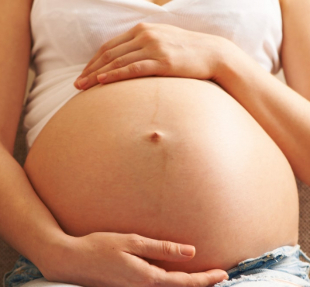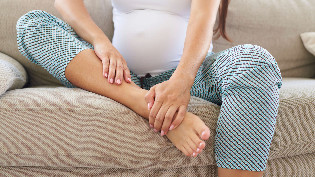
In many ways, pregnancy can be a time of phenomenal changes in a woman's body. As a woman prepares to have a baby soon, she may notice some unexpected side effects. These may include thicker hair growth, shine and stiff nails, shiny skin, and an increase in breast size and fullness.
Unfortunately, not all pregnancy changes are desirable and enjoyable. There will be significant weight gain, mood swings, and frequent urination. This is due to the fact that pregnancy is associated with profound changes in the female body due to the restructuring of the hormonal background. Veins also undergo significant changes - their tone decreases, wall permeability increases and blood flow slows down. Varicose veins are one of the diseases that can first appear during pregnancy or start to progress actively.
WHAT IS A DIFFERENT DISEASE
Varicose veins of the lower extremities are veins with persistent and irreversible varicose veins that result from gross changes in their walls, as well as from insufficiency of their valve apparatus due to a genetic defect. The main factors in the appearance of varicose veins are hereditary weakness of the vascular wall. Secondary factors leading to varicose veins are prolonged stress in the lower extremities.
Statistics show that 40-65% of expectant mothers develop varicose veins at least once in their lifetime. Most obese women suffer from varicose veins during pregnancy.
Although varicose veins are most common in the legs, they can occur elsewhere. Especially in late pregnancy, twisted veins can appear in the buttocks, vagina or vulva. This occurs when the lower abdomen and uterus exert increased pressure on the veins in these areas.
CAUSES OF VARICOSIS DURING PREGNANCY
As the term grows during pregnancy, a number of changes occur that create the preconditions for varicose veins.
- First, the uterus, as it grows, puts pressure on the inferior vena cava - the largest vein in the human body. Excessive pressure creates a slowing of blood flow, placing more stress on the veins in the legs, which hold more blood. This leads to varicose veins during pregnancy on the legs. Second, during pregnancy, the female body produces more blood to support the developing baby, the uninterrupted delivery of oxygen and nutrients to the placenta and fetus. Due to the added load, the veins have to work harder to pump carbonated blood back to the heart from the extremities and pelvis. This can lead to insufficiency of the venous valves and accumulation of blood in the legs, ankles, feet and other areas. Third, an increase in female sex hormone levels during pregnancy reduces smooth muscle tone in the walls of blood vessels (especially veins). It can also contribute to varicose veins in pregnant women.
VARICOSIS RISK FACTORS DURING PREGNANCY
Varicose veins are considered to be a disease with hereditary predisposition. If the mother or grandmother suffered from varicose veins during pregnancy, a woman’s risk of developing this disease increases dramatically.The incidence of varicose veins increases with age, weight gain and any subsequent pregnancies. If a woman carries twins or triplets, the risk of getting varicose veins in pregnant women on legs doubles.
Lifestyles and work habits (long hours standing or sitting still) can also provoke varicose veins.
Symptoms of varicose veins in pregnant women
Some women have slightly swollen, twisted, multi-colored veins in their legs - just a cosmetic issue. In others, varicose veins during pregnancy provoke unpleasant symptoms - swelling, pain or severe discomfort in the legs. In all women with varicose veins in the legs, this is a major sign of varicose veins. If left untreated, venous damage can lead to serious complications, including blood clots, phlebitis, and trophic ulcers. In addition, the risk of a fatal complication - PE (pulmonary embolism) - increases.

Throughout pregnancy, you should monitor for signs of varicose veins:
- edema in the area of the feet and ankles, feet;
- spasm or soreness in the thigh or lower leg;
- fatigue, leg weight;
- discomfort, especially at night, desire to constantly move legs;
- itchy skin, dry or pale feet, burning sensation;
- twisted, protruding "stars", larger veins entangled;
- sores on the feet or ankles that take a long time to heal or do not heal at all;
- leg pain that goes away when a woman walks or lifts her legs.
WILL V varicose veins be the best during pregnancy?
Unfortunately, varicose veins often get worse as the pregnancy progresses. As the saphenous veins dilate, shake, swell, and become more visible, the woman increasingly notices increased pain and other symptoms (swelling, skin changes, weight).
VARICOSIS DURING PREGNANCY: WHAT D D B DNI
If a woman experiences any symptoms of varicose veins, it is imperative to visit a phlebologist. After performing a thorough physical examination, carefully assessing the condition of the legs, ankles, feet and thighs, the doctor will confirm the presence of varicose veins and rule out possible complications (using Doppler ultrasound and vascular measurements). . As for varicose veins in the vulva, the obstetrician-gynecologist will notice it during a routine examination.
TREATMENT OF VARICOSIS IN PREGNANT WOMEN
Most often, minimally invasive surgery and procedures are not prescribed to treat varicose veins during pregnancy. This is associated with a high risk of complications and recurrences. In addition, the description of drugs - phlebotonics, anti-inflammatory agents, antirobocytic - is very limited.
There are a number of guidelines that help in the safe and relatively effective treatment of varicose veins in expectant mothers.
- Dosed physical activity. Swimming, walking or other exercises for pregnant women with varicose veins, which involve the leg muscles, help increase blood circulation to the veins of the extremities. The phlebologist, together with the obstetrician-gynecologist, will choose an individual set of exercises for a specific period and severity of the pregnant woman's condition.
- Properly placed shoes. High heels and a completely flat sole interfere with the movement of the leg muscles, impairing venous blood circulation. You need to choose durable, comfortable shoes with a small heel (3-4 cm).
- Compression jersey. To support the veins during pregnancy, it is necessary to wear a compression dressing. The phlebologist will individually choose the degree of compression and the type of product - knee lift, socks or sweater. You should wear them in the morning, without getting out of bed, and remove them in the evening when a woman goes to bed.
HOW TO BELNI VARICOSIS DURING PREGNANCY
There are a number of tips for preventing varicose veins in pregnant women, following which will help ease the course of the disease and reduce anxiety:
- Do not cross your legs. Sitting with one foot on the other blocks blood flow through the veins and can cause increased pressure.
- Change position. If you have to sit or stand all day at work, change your posture as often as possible. This prevents blood clots in the legs.
- Sleep on your left side. As your abdomen gets bigger, lying on your back will become difficult. For varicose veins, try to sleep on your left side, not your right. This prevents pressure from the uterus into the veins in the abdominal cavity and helps blood flow from the lower extremities at night.
- Raise your legs. Raise your legs more often throughout the day. Ideally, they should be above the level of the heart so that the force of gravity helps blood flow more actively. While lying in bed, you can rest your feet on a pillow to help blood flow during sleep.
- Check your salt intake. When you take too much salt, more fluid flows into the blood vessels, which can increase the pressure in your veins. Excess fluid penetrates the tissues and leads to edema. Drink plenty of water to help your body maintain proper fluid balance.
- Keep track of your weight. The female body changes during pregnancy, the expectant mother is gaining weight. The higher the body weight, the more pressure the weight exerts on the veins of the lower extremities. The doctor will evaluate the gains and clarify the weight rates.
VARIOSIS AFTER BIRTH
The most important concern for expectant mothers is whether varicose veins will disappear after pregnancy? Varicose veins usually disappear 3 months after the baby is born. If the changes do not go away after 3 months, you should contact a phlebologist.
Manifestations of varicose veins that first appeared when carrying a child usually disappear with little or no treatment. However, the more severe the changes, the more likely they are to remain postpartum and require treatment. Varicose veins in the vagina or vulva almost always resolve naturally after birth.What are the complications of varicose veins
Varicose veins can lead to serious complications. The risk of developing dangerous conditions is increased: blood clots and venous ulcers.
There are two main types of blood clots. Superficial venous thrombi form in the saphenous veins. They do not usually migrate to the lungs. Dangerous deep vein thrombosis. Blood clots formed in them can break down and enter the pulmonary vessels. Importers It is important to see a doctor immediately if:
- varicose veins become hard, like a rope;
- the surrounding tissues are hot, painful or swollen;
- there are noticeable changes in the color of the vein;
- ulcers appear on the skin;
- a painful, severe swelling appears in one leg.
In these cases, the phlebologist will determine treatment tactics, including minimally invasive surgical methods, to eliminate inflammation, the risk of life-threatening complications.























